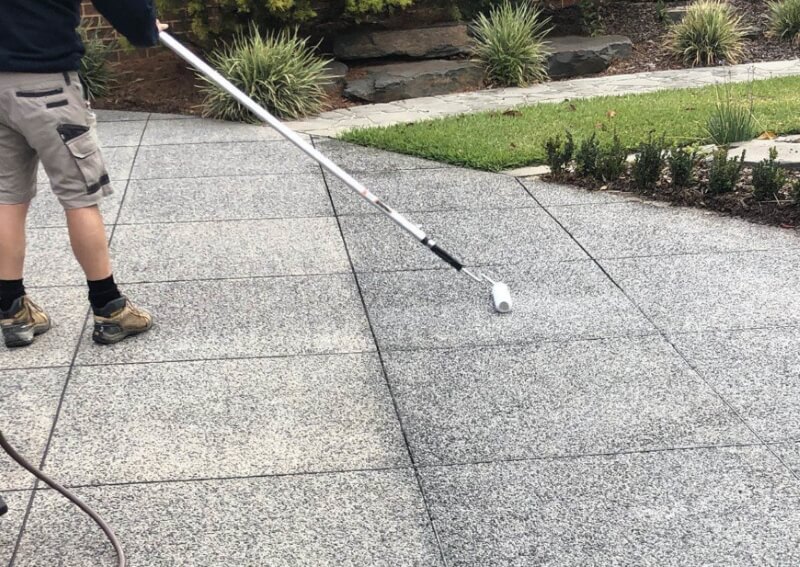
Concrete sealing is a crucial step in protecting and preserving the integrity of concrete surfaces. This process involves applying a protective sealant to the concrete, forming a barrier that shields it from moisture, chemicals, stains, and other damaging elements. The process of concrete sealing isn’t complex but it’s important to do it right to ensure the proper sealing of the concrete to prevent further damage.
To perform residential concrete sealing, you will need a few essential materials and equipment. Firstly, you will require a high-quality concrete sealant, which can be either solvent-based or water-based, depending on your preference and the specific needs of the concrete surface. Other necessary items include a paint roller or sprayer to apply the sealant evenly, a paint tray or bucket for pouring the sealant, and a long-handled roller or brush for edging and reaching tight corners. Additionally, you may need a pressure washer or cleaning solution to thoroughly clean the concrete before sealing. Safety equipment such as goggles, gloves, and a mask is also recommended.
The first step in concrete sealing is preparing the surface. This involves thoroughly cleaning the concrete to remove dirt, debris, and any existing stains. A pressure washer or a combination of detergent and scrubbing can be used to ensure a clean and smooth surface. Once the surface is clean, it is essential to allow the concrete to dry completely before proceeding with the sealing process.
After the concrete surface is clean and dry, the next step is to apply the sealant. There are various types of sealants available, including acrylic sealers, penetrating sealers, and epoxy coatings, each with its specific advantages and applications. The sealant is typically applied using a brush, roller, or sprayer, ensuring even coverage over the entire surface. It is important to follow the manufacturer’s instructions regarding application techniques, drying times, and any necessary multiple coats.
The sealant forms a protective layer on the concrete, acting as a barrier against moisture intrusion. One of the primary benefits of concrete sealing is preventing water damage. Moisture can penetrate the concrete, leading to cracks, spalling (surface flaking or chipping), and deterioration over time. By sealing the concrete, you create a waterproof barrier that prevents water from seeping into the material, thus reducing the risk of these damaging effects.
In addition to water damage, concrete is also susceptible to damage from chemicals, such as oil, grease, and harsh cleaning agents. Sealing the concrete provides a protective layer that resists the penetration of these substances, making it easier to clean and reducing the likelihood of stains or discoloration. This is particularly important for driveways, garage floors, and other concrete surfaces that are exposed to vehicles or potentially harmful substances.
Sealing concrete also helps to preserve its appearance and extend its lifespan. The sealant enhances the color and sheen of the concrete, giving it a more vibrant and aesthetically pleasing look. It can also help to prevent fading and discoloration caused by UV rays from the sun. By protecting the concrete from environmental factors, sealing can slow down the natural aging process and maintain the visual appeal of the surface.
Furthermore, concrete sealing plays a significant role in preventing the growth of mold, mildew, and other microorganisms. Moisture trapped within the concrete can create a favorable environment for these organisms to thrive. By sealing the concrete and preventing moisture infiltration, you reduce the risk of mold and mildew growth, which can cause health issues and further damage to the concrete.
It’s important to note that the frequency of concrete sealing depends on various factors such as the type of sealant used, the level of exposure to elements, and the amount of traffic the concrete surface receives. In general, it is recommended to reseal concrete surfaces every 2 to 5 years to ensure continued protection.
In conclusion, the process of concrete sealing involves preparing the surface and applying a protective sealant to shield the concrete from moisture, chemicals, stains, and other damaging elements. Sealing concrete is important to prevent further damage by reducing the risk of water infiltration, chemical stains, and the growth of mold and mildew. It helps to maintain the appearance and extend the lifespan of the concrete, making it a worthwhile investment in the long-term durability and aesthetics of the surface.